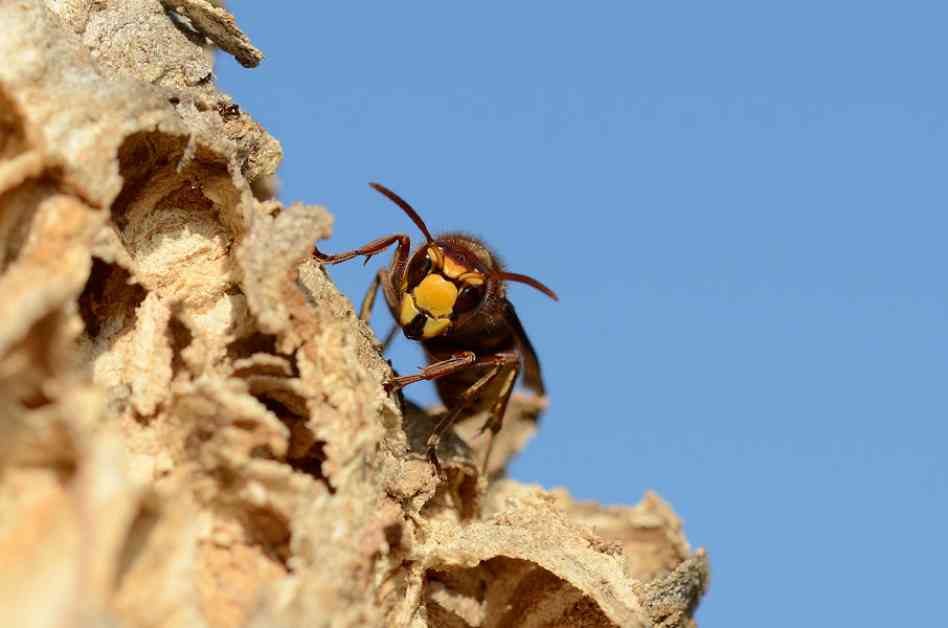A loud buzzing in the room – that would probably startle most people. Especially in the summer, when windows are left open overnight, hornets sometimes find their way into illuminated indoor spaces. These animals are active at night and, like many other nocturnal insects, are attracted to light. Due to their impressive size of around 25 millimeters and the misconception that their stings can be deadly to humans, many people react fearfully to the animals. „However, the venom of the hornet is comparable to that of other bees and wasps,“ explains Miriam Plappert, nature conservation expert at BUND Baden-Württemberg. „The sting can be more painful due to the larger stinger and a higher proportion of the neurotransmitter acetylcholine.“ Nevertheless, only 500 to 1,000 stings would be life-threatening for healthy adults. But be careful: if there is an allergy, even one sting can be dangerous.
Less lighting helps humans and animals
By using insect screens on windows, you can prevent hornets or other animals from entering the apartment. To avoid attracting the animals in the first place, it is advisable to reduce lighting in and around the house, as well as in the garden or on the balcony as much as possible. „Artificial light is harmful – especially if it shines all night long,“ emphasizes the expert. Nocturnal insects buzz aimlessly around light sources until they become exhausted. Fewer insects also mean less food for other animals such as amphibians and bats. These and other nocturnal mammals like hedgehogs usually avoid brightly lit areas and consume unnecessary energy to avoid light pollution. But even diurnal animals like songbirds suffer when their nighttime rest is disturbed by bright lighting.
Long live the queen!
In the late summer, the first males and young queens of the hornets (Vespa crabro) are growing. In the late summer, they leave the nest to mate. Only the mated queens, which can grow up to 35 millimeters, hibernate. They survive the cold season thanks to their body’s natural antifreeze, while all other animals die at the first frost. In late spring, the queens fly out again to search for food and establish a new nest. Naturally, they use tree cavities as nesting sites. If these cannot be found, they are happy to resort to old sheds, niches in attics, or wooden cladding on balconies. The queen herself builds the first combs and protective covers by chewing wood fibers into a papery mass. Then, her majesty lays the fertilized eggs from the previous year, from which the workers hatch, who take over the further nest construction for her.
Diet from animal to plant
The court of a hornet queen can consist of up to 700 animals. While adult animals mainly feed on plant sap and fallen fruit, the offspring are mainly fed other insects. With their mandibles, the larvae scratch the walls of their combs to signal hunger. This prompts the workers to hunt up to 500 grams of smaller wasps, bees, grasshoppers, beetles, or flies daily. However, only the protein-rich thorax is good enough for the offspring – the caring providers immediately remove the head, wings, and legs of their prey.
Tips for encounters with hornets
If you want to observe the fascinating animals with the wasp waist, red-brown chest color, yellow-black striped abdomen, red-brown legs, and hektische Bewegungen, avoid standing in the flight path of the animals.
• Do not breathe on the animals.
• Keep at least three meters away from the nest. Our native hornets are protected. This means they may not be killed, and disruptive nests may only be relocated by trained individuals. In some districts of Baden-Württemberg, there are now trained, volunteer hornet consultants. Inquire at the Lower Nature Conservation Authority at your district office (in urban districts: city administration) if this consulting service is available to you and what help these experts provide.
Unpopular relatives: The Asian hornet
For several years now, the Asian hornet has been spreading further and further in Baden-Württemberg. The smaller and darker animals are particularly feared by beekeepers and bee enthusiasts. If you spot the animals or one of their nests, you should report it to the Baden-Württemberg State Institute for the Environment. Around 2000 confirmed sightings and over 550 nests of the animals were reported there in 2023.
Photo for reporting
You can use the image free of charge in connection with reporting on the BUND NaturTipp and by stating the photo author listed in the file name: https://cloud.bund.net/index.php/s/6CxSZEkjJjBMsQ7
Contact for inquiries
Miriam Plappert, nature conservation expert at the Friends of the Earth Germany (BUND), Baden-Württemberg State Association, miriam.plappert(at)bund.net, 0711 620306-14
Additional Information
• Wasps and hornets
• Nocturnal light and insect decline
• Discover native species
• Project Night Saver
• Asian hornet

